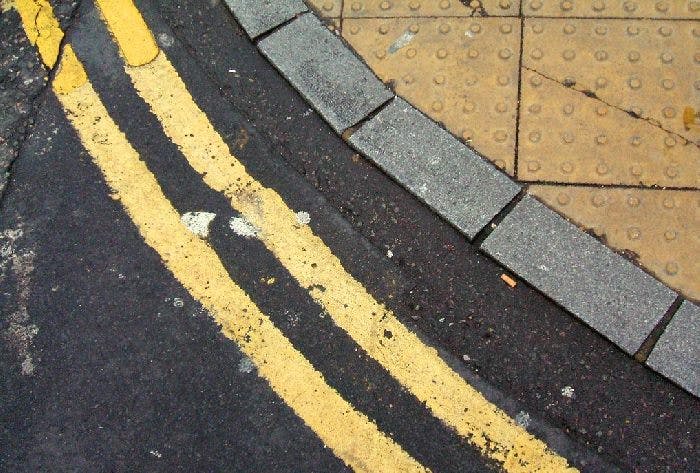
When you're out and about on the road, you'll notice that there are signs and road markings dotted all over the place. Before you learn to drive, you might find a lot of these symbols confusing. And that's fair enough! They come in many different shapes, colours and sizes. Once you crack open that highway code, though, things start to get a lot clearer.
As a driver, one of the most important (not to mention common) road markings you need to understand are yellow lines. You can find them in double and single form, painted along the sides of certain roads. But what do they mean? Well, in a nutshell, yellow lines indicate that some kind of waiting restriction is in force.
That's barely scratching the surface, though—there are a range of variations you need to understand to avoid breaking the rules and being slapped with a fine. Luckily for you, we're about to explain all! So, buckle up as we delve into everything you need to know about single and double yellow lines...
What are yellow lines?
Yellow lines are designed to let drivers know that waiting on that road (this applies to the carriageway, pavement and kerb) is prohibited. Now, 'waiting' in this context refers to any of the following:
- Parking up your car and leaving it unattended
- Parking up your car and remaining in the vehicle
- Dropping someone off
- Picking someone up
- Parking the car to unload something
- Parking the car to load something into it
Such restrictions might be in place indefinitely, or may only apply at certain times of the day or week. In order to figure out which it is, you first need to clock whether there are one or two yellow lines.
Single yellow lines
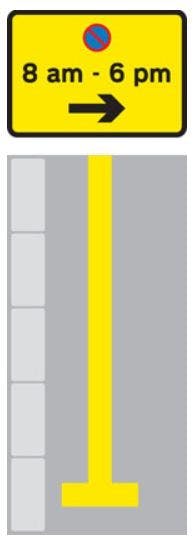
Single lines are an indication that waiting restrictions are in place, but only at certain times. They are often implemented to prevent congestion in busy areas and thus ease traffic flow. In order to work out at what times you are able to wait and park on these roads, you need only look for the corresponding signage.
Specific information about the waiting restrictions on a road with single yellow lines will be displayed on yellow signs nearby. They usually depict a time frame spanning a few days of the week or specific times of the day. For example, the sign may read 'Monday - Friday', or '8am - 6pm'. You are prohibited from waiting or parking during the specified times.
If a sign on one of these roads does display times rather than days, it indicates that these restrictions apply to every day of the week. That includes weekends and bank holidays (again, unless specified otherwise). So, when you're looking for a space to pull over and you find yourself on a road with single yellow lines, be sure to check the information displayed on the relevant signs.
If you're outside the prohibited time frame, you're good to go! Otherwise, keep moving. It doesn't matter if the road is empty, or you don't think parking there will cause any problems for other traffic—you must obey what the sign says.
Double yellow lines
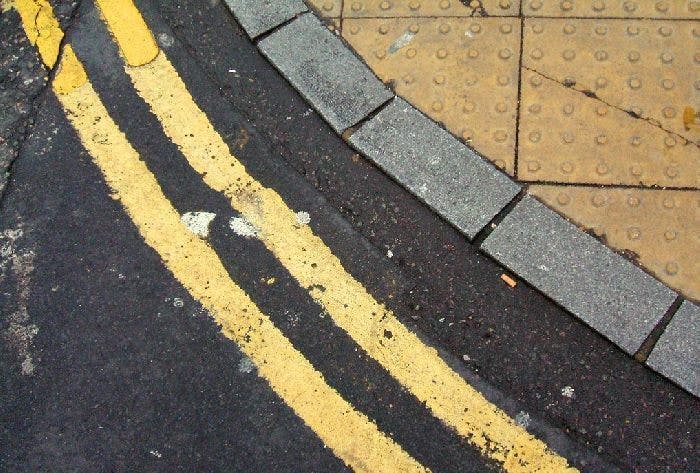
Double yellow lines are a lot more straightforward, but no so great to come across when you really need a place to park! If you see double yellow lines along the side of a road, it means that parking or waiting here is prohibited at all times. It is worth double checking the corresponding signage, however, as in rare cases seasonal exceptions may be in place.
No signage to be found? You can pretty much count on the fact that the option of parking here is completely off the menu. If you really are in doubt, specific rules relating to double and single yellow lines are generally administered by the relevant local authority. So, for information related to your personal stomping grounds, contact the council that is in charge of your area.
What happens if you break the rules?
Now for the bit you're probably most interested in: what actually happens if you park on these roads during prohibited hours? Well, first off, you're setting yourself up to have a not-so-pleasant run in with a civil enforcement officer. More commonly known as traffic wardens, these folk rarely come baring good news.
In fact, they usually come wielding parking tickets, and that's exactly what you'll get for being on yellow lines illegally. If you're in your vehicle, they'll hand it to you directly with an explanation as to why you're receiving it. But don't worry if you've left your vehicle unattended—they'll be nice enough to pop the ticket on the windscreen for when you return. Thoughtful!
Penalty charge notice (PCN)
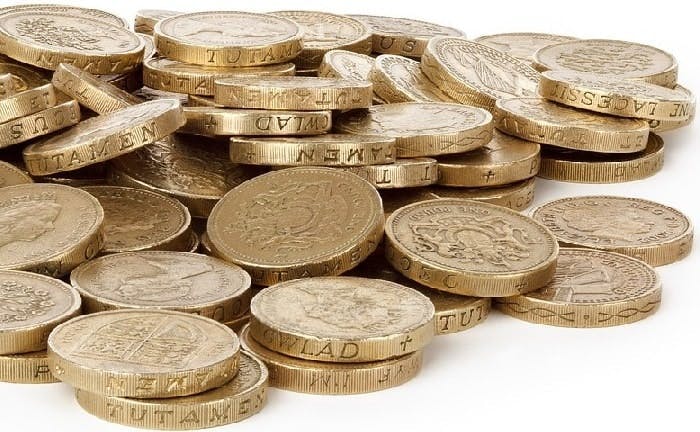
To get specific, the parking ticket presented in these scenarios is known as a Penalty Charge Notice (PCN). On it you'll find the date of issue, the amount you're being fined and the time window in which you must cough up the cash. The amount you have to pay varies depending on your local council, with fines currently ranging from around £60-£90.
From the day you receive a PCN, you have 28 days to pay the fine. Want to cushion the blow? If you pay off your ticket within 14 days, you only have to hand over 50% of the stated figure. So, if your fine is £90 but you decide to hand over the money straight away, you only have to part with £45. On the other hand, if you fail to pay the fine within 28 days, another 50% will be added on to the amount owed and you have 14 days to settle the bill.
This isn't the kind of issue you can ignore until it goes away. In fact, taking the head-in-sand approach will only make things a lot worse! Continuously failing to pay a parking fine can lead to a court order and even bailiffs showing up at your residence to seize the funds. All that for a parking spot? No thank you!
Exceptions to the rule
Most rules come with one or two exceptions, and those surrounding yellow lines are no different. Yes, certain people are allowed to flaunt the yellow lines rules and certain circumstances allow for a little leeway.
Loading and unloading
If you need to stop on a road marked with single or double yellow lines to load/unload your vehicle, you may do so as long as the action is continuous. In other words, you can't take your time or stop for breaks in between. There is a window of 20-40 minutes during which you can do this, depending on whether you are driving a commercial vehicle or not. Again, to find out the specific rules for your area, contact the local council.
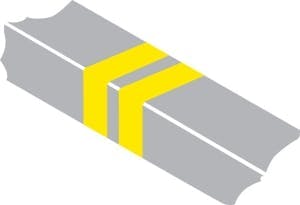
When it comes to loading, you need to be aware of another yellow road marking. We're talking about yellow lines on the actual kerb, which indicate that loading is prohibited. Similar to the waiting restrictions, these appear as single or double lines and the same rules apply. So, a single yellow line on the kerb means loading is limited to a specific time frame (which will be indicated on a nearby black and white sign) and a double yellow line on the kerb means that loading is not permitted at any time.
You are also allowed to briefly stop on roads marked with yellow lines to drop off and pick up passengers, as long as this is done in a timely manner. Once again, the process must be continuous and without unnecessary delay—so no dawdling! Find out more about when you can and can't park on pavements so you don't get caught out.
Blue Badge holders
If you happen to be a blue badge holder—good news! You are allowed to park on single and yellow double lines for 3 hours. Just make sure that your badge is clearly displayed on the vehicle and you are not causing an obstruction of any kind, e.g., you must be at least 15 metres away from the nearest junction. Keep in mind that you still cannot park next to a kerb with yellow lines that indicate loading restrictions.
Not sure what a blue badge is? It's a permit that allows disabled drivers and passengers to park closer to their destination. If you think you may be eligible for one, explore the topic on the GOV.UK website.
Easy-going enforcement officers?
A brief warning: we're getting into myth territory here. Many rumours circulate in the driving world, often sparked by one-off situations which people then apply as a general rule. A surprisingly prevalent myth that surrounds the rules regarding yellow lines is that traffic wardens who see people waiting on yellow lines will give it 3-5 minutes before issuing a ticket.
Now, we don't know about you, but if we were parked on a yellow line road (unlikely as the highway code is our bible!) and a traffic warden appeared, we would be inclined to scarper pretty quickly. If, however, you have faith in this myth and fancy your chances, do let us know how you get on!
In all honesty, we imagine it just depends on the officer in question. If they happen to be in a good mood, they might give you a little wiggle room. Then again, if they are having a bad day, you could be hit with a parking ticket faster than you can say, “That reflective vest really brings out your eyes!”.

Red lines
Just when you thought you had this coloured road lines thing down, we're throwing another one into the mix! In some places, you'll find that red lines are painted along the side of roads instead of yellow ones. In London, for example, this indicates that you are on a so-called red route. The rules are pretty much the same as those for yellow lines—double means no waiting at all, single means no waiting during specified times.
Unlike yellow lines, the signs explaining the exact restrictions on the road are black and white with a red border (as opposed to yellow). Exceptions are often made for both blue badge holders and licensed taxis, but you would need to contact the local authority to find out what these are.
If you need to park on a street with red lines, look out for a white or red box marked out on the road. A white box is available to use throughout the day, whereas a red box is only available to use during—you guessed it!—the hours specified on corresponding signs.
How to avoid parking on yellow lines
The most obvious way to avoid parking on yellow lines is to plan where you're going to leave your car ahead of time. Of course, if you're heading to a place you've never been before, this might seem a little tricky. It's actually not though! May we remind you that we live in the age of the internet. There are plenty of websites out there that can provide you with all the parking options in a particular area. So, before setting off, enter your destination into a site like Parkopedia and note down your best options.
In most cases, following the rules and avoiding fines just requires a little common sense. Make sure you read all signs very carefully, particularly those relating to single yellow line restrictions. If you know you're heading into a heavily congested area, consider leaving the car at home and taking public transport. Finding a parking spot can be a nightmare these days—with or without the presence of yellow lines!
TL;DR — A Fast Summary of Yellow Line Rules
- Double yellow lines = You should never park or wait there
- Single yellow lines = You probably can't park or wait there. Look around for signs stating the rules — you're prohibited from waiting or parking during the specified times/days.
- Blue badge holders can usually park on single- or double-yellows for up to 3 hours unless there are loading restrictions (look for signage and/or pairs of yellow lines over the edge of the kerb)
As long as you know your stuff, you should be able to keep the traffic wardens at bay. If you find road markings confusing or find that you forget the exact rules when out and about, it's worth keeping a copy of the highway code in your car. A little geeky? Sure, but you'll be thankful it's there when you find yourself in a pickle. For future reference, you can find everything you need to know about waiting and parking in sections 238-252. Read up and stay savvy!
Subscribe for driving advice, offers & more
We'd love to let you know about our courses, news and offers via email. You may unsubscribe at any time.
Star Genie Limited trading as PassMeFast. Company number 10093359
Copyright © 2024 owned by Star Genie Limited
PassMeFast, Blue Tower, MediaCityUK, Salford, M50 2ST
